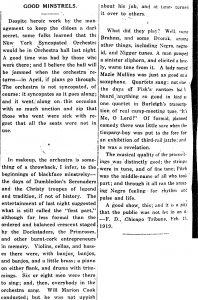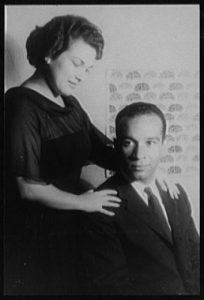While most American “classically trained” musicians around the turn of the 20th century were white, a notable figure making strides to change that was found in Albert Mando, a black composer, conductor, and educator. Founder of the Mando Mozart Conservatory, a New York based music school for African Americans, Mando was considered “the most distinguished negro teacher and leader of music in the United States” at the time of his death in 1912.

 For the decades that he ran the school, Mando and his students received plenty of attention from black run press. Being the only conductor of color of a “musical art and symphony society” of his time, he was seen as a dominant figure in paving the way for black classical musicians.
For the decades that he ran the school, Mando and his students received plenty of attention from black run press. Being the only conductor of color of a “musical art and symphony society” of his time, he was seen as a dominant figure in paving the way for black classical musicians.
Anther notable black conductor of the time is Walter F. Craig, founder of Craig’s Orchestra. A large difference between Craig’s and Mando’s ensembles is that while Mando had entirely black students, Craig’s Orchestra was around half white for the first several decades of its existence. However, Craig’s impact may be just as great, introducing many black musicians to the stage as solo artists.
While Mando and Craig had a tremendous effect on black musicians being accepted in classical settings, it would still be several more decades before black conductors would direct major all-white groups. We recognize names such as William Grant Still, Everett Lee, and Henry Lewis because of their own incredible contributions to the music world, but much of the work to get African American classical musicians accepted at an equal level to white ones was started decades before by people most have forgotten.
Works Cited
“Albert Francis Mando (1846-1912) Composer, Conductor, and Instructor of Music.” Lansingburgh Historical Society, Lansingburgh Historical Society, 3 Feb. 2017, www.lansingburghhistoricalsociety.org/in-the-news/albert-francis-mando-1846-1912-composer-conductor-and-instructor-of-music.
“Craig’s Christmas Reception.” New York Age, 1891, p. 3. African American Newspapers, Accessed 11 Oct. 2024.
“In the Musical Realm. What Mr. Albert F. Mando Is Doing to Popularize; the Classics-a Rare Treat.” Colored American, 1899, p. [2]. African American Newspapers, Accessed 11 Oct. 2024.
“Mando’s Orchestra. A New York Musician Developing in the Negro Race a Taste for the Classic.” Colored American, 1902, p. 10. African American Newspapers, Accessed 11 Oct. 2024.
“A Noted Musician. The Greatest Conductor of the Negro Race.” Colored American, 1903, p. 2. African American Newspapers, Accessed 11 Oct. 2024.



